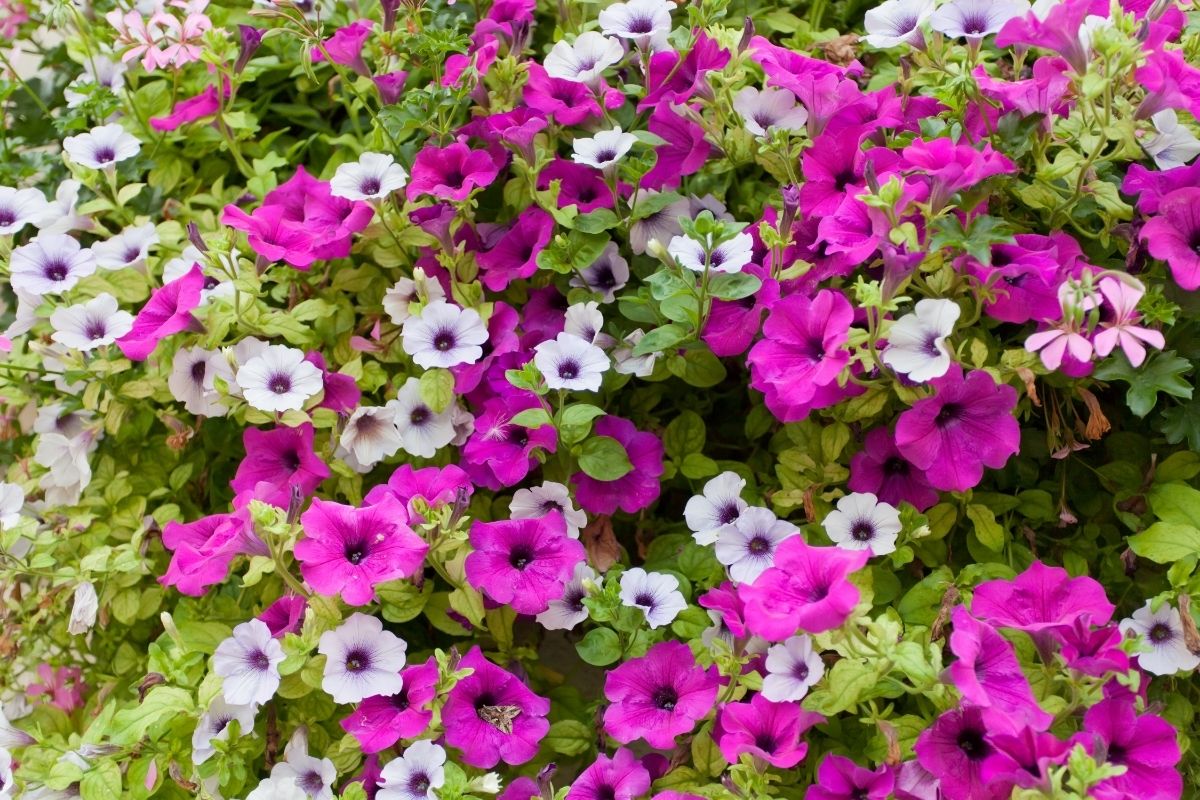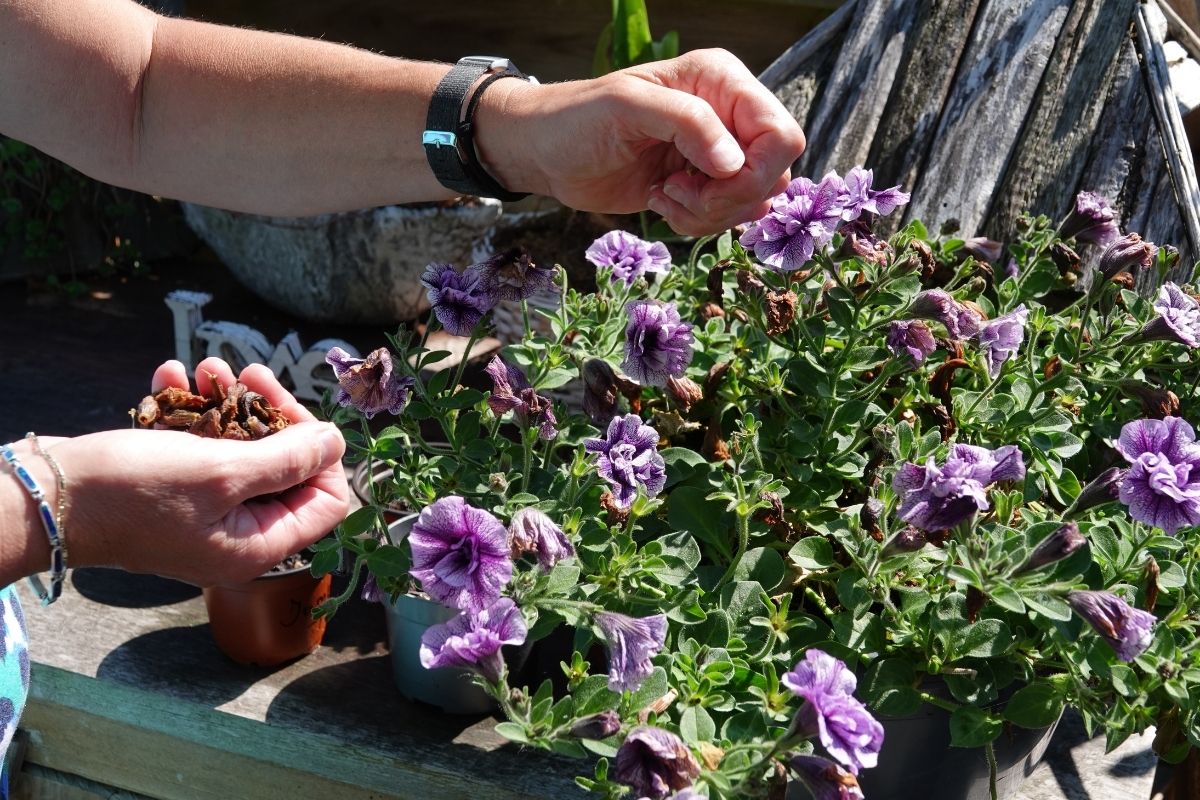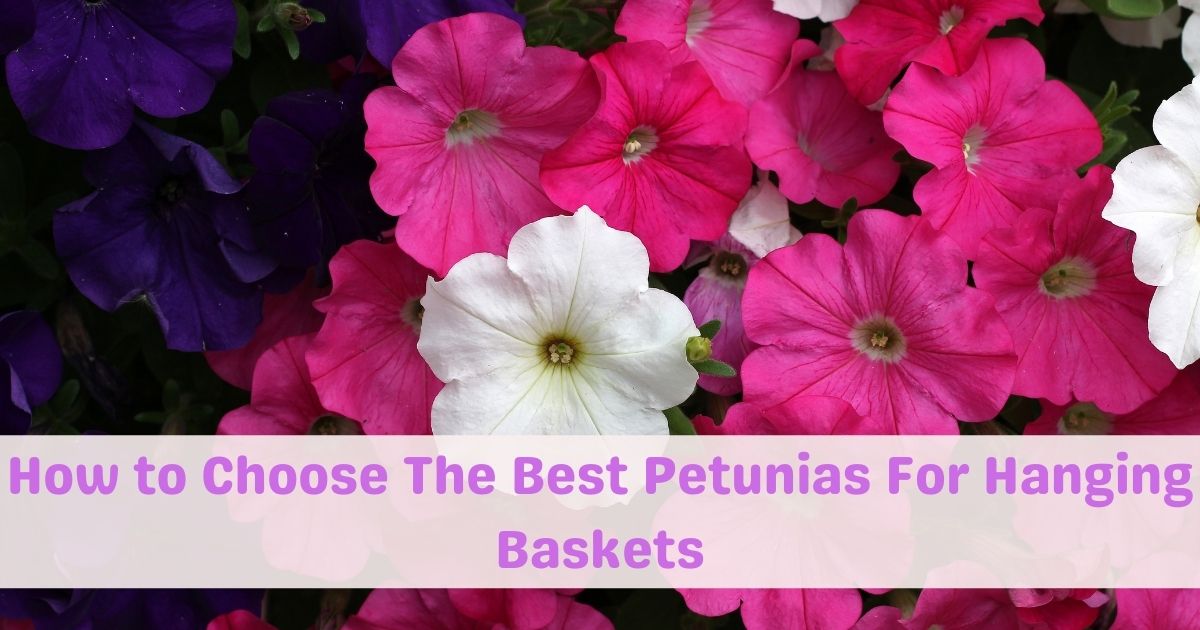What Are Petunias?
Petunias are a common bedding plant. You will find them in large hanging baskets on bars and lampposts. But are you aware of the best petunias for hanging baskets? Read on to get the insight!
There are two types of bedding petunias:
- Multifloras have a lot of tiny blooms that do better in harmful conditions.
- Grandifloras have fewer huge, floppy blooms and should be grown sheltered to avoid being damaged by wind and rain.

Are Petunias Good Plants For Hanging Baskets?
Petunias are the best plants for hanging baskets because they tend to mound and pour out over the sides of the basket. Their cascading effect makes for a beautiful addition to your home! Wave petunia baskets are perfect for hanging baskets as they don’t require any deadheading.
The Different Types of Petunias You Can Grow
Petunias, bright annuals that bloom reliably from early summer until the first frost in autumn, have a lot to offer. They come in various colors, sizes, and shapes. Petunia plants come in four different varieties.
All four come in series, plants with similar sizes and flowering behaviors. Each series has only one distinguishing feature: the spectrum of petunia blooms. Grandiflora petunias are the oldest varieties since 1950.
On bouquet-shaped plants, Grandiflora petunia cultivars have flowers spanning up to 5 inches (12.5 centimeters) across. Although the blossoms are magnificent, they are weary and spindly by midsummer.
The optimal conditions for Grandiflora petunias are mild summers with little humidity or moisture. Ultra Dream, Storm Daddy, Super Magic, and Super Cascade are among the Grandiflora petunias range.
Multiflora petunias are smaller plants with more blooms, but they are smaller. Multiflora petunia types are suitable for windy climates since their stems are sturdy. The flowers last a little longer than Grandiflora petunia kinds, especially when it rains.
Single and double types of Multiflora petunias are available. Among the most popular Multiflora petunias are:
• Primetime
• Celebrity
• Carpet
• Horizon
• Mirage
• Primetime
Milliflora petunia types produce masses of 1 to 12-inch (2.5 to 4 centimeters) blooms. The plants reach a mature height of around 8 inches (20.5 centimeters), tall and broad. Milliflora petunias are popular in containers and hanging baskets because they bloom early. Picobella and Fantasy are Milliflora petunias.
Wave petunias, or spreading petunias, are a newer addition with flowers typically 2 inches (5 cm) across. The plants look excellent in containers and function well as ground covers, spreading 2 to 4 feet (0.5 to 1 meter) at the end of the season.
They survive heat and drought well and don’t require deadheading in most cases. Wave petunias include the following varieties: Shock Wave Avalanche (Easy Wave).
How to Choose the Best Petunias for Hanging Baskets
Grandiflora Petunia
Grandifloras are one of the earliest types of flowering plants. These petunias grow 8 to 12 inches (20.32 to 30.48 centimeters) tall and have the same enormous 4 to 5-inch (10.16 to 12.7 centimeters) wavy-edged flowers that made petunias famous. Single or ruffled double blossoms are available.
Grandiflora petunias have the largest flowers, but they get battered by rain and develop into a mushy mass that’s difficult to deadhead—which you’ll have to do if you want them to keep flowering. The stems will grow long if the spent blooms are left, but no new buds will emerge.
However, some standouts, like the creamy yellow ‘Prism Sunshine,’ are so beautiful that the effort is well worth it. Both beds and containers benefit from Grandifloras.
Petunia Multiflora
The growth habit of multiflora petunias is more compact than that of Grandifloras. As a result, the flowers are smaller, measuring approximately 2 inches (5.08 centimeters) in diameter, but they are more numerous and resistant to rain. There is also a large variety of hues to choose from.
Multiflora petunias are better for garden beds than Grandifloras because of their mounding nature, and they also work well in containers.
There are also petunia Grandiflora and Multiflora petunia hybrids that combine the best of both varieties. They were put in categories, the floribundas, to describe them. Petunias with little or large flowers are now available as floribunda petunias.
Wave Petunia Series
The wave series caused quite a sensation, and the flowers have only become better since then. Wave petunias only reach a height of 6 inches (15.24 centimeters) but can spread to a width of 4 feet (1.23 meters).
Wave petunias do not require deadheading, which is another quality that makes them worthwhile to grow. They do, however, wear out during the warmest part of the summer.
Wave petunias’ flowering is reduced by prolonged heat but can revive it with pruning. Wave petunias make excellent groundcovers and container trailers. A ‘Tidal Wave’ series is also available, slightly more upright.
Petunias Supertunias
You propagate the Supertunia series via cuttings rather than seed. The Proven Winner plant range includes Supertunias. Supertunias are fast growers and bloomers, but they need to eat frequently to keep themselves at their best.
They will blossom and bloom if you feed them a bit every time you water them, or at least once a month. Supertunias are also resistant to the elements.
Surfinia Petunias and Cascadia Petunias
Petunias like Cascadia and Surfinia are also popular. These are grown for their trailing habit, vibrant colors, and plenty of flowers. They usually feature large, unusually colored flowers, similar to regular petunias. With these petunias, you’ll find a lot of intriguing shading and veining.
They’re also low-maintenance, spreading or trailing to around 18 inches (45.72 centimeters). Hanging baskets and window boxes are ideal for these petunias.
Calibrachoa (Million Bells, Superbells)
Calibrachoa (Million Bells or Superbells) resemble miniature petunias but separate species. They are, however, becoming increasingly popular and may be ideal for use in a hanging basket. Calibrachoa hybrids have the most significant characteristics of hybrid petunias, including long-blooming, no deadheading, and weather tolerance.
Petunias with odd colors, such as gold and terra-cotta, are also available.
How to Grow Petunias in Hanging Baskets
If you have your plants and you are ready to pot them up in a hanging basket, here’s the process:
1. Prepare your hanging basket: Grab your hanging basket and fill it up to a few inches/centimeters shy of the brim with potting soil.
2. Unpack your Wave petunia plants: Pull the Wave petunia plants from their pack or pot by squeezing the bottom of the container and gently pulling the plant out. You can turn the container upside down as you do this to get gravity on your side.
3. Stage your Wave petunia plants: Stage your plants in the hanging basket the way you will like them. This encourages the plant to spread its roots out in the new soil.
4. Plant the Wave petunia hanging basket: Cover the Wave petunia plugs up to match the soil line of the plants.
5. Water the plants: Water the Wave petunia basket and apply slow-release fertilizer (if not already included in your potting soil).

How to Care for Petunias in Hanging Baskets
Don’t Overpack your Basket
Wave petunias are robust growers. When the Wave petunia plants are young, don’t overfill the basket. While not as strong as Supertunias, wave petunias can nevertheless outcompete other plants in a hanging basket.
You might get away with only one Wave petunia per hanging basket, but many will plant three for a lovely show (stick with odd numbers). Depending on your basket size, three plants should be plenty for a 12-inch (30.48-centimeter) basket. In a hanging basket, space Wave petunias evenly among other plants.
Choose a Hanging Basket with Good Drainage
Choose a hanging basket with suitable drainage holes. This will help protect the Wave petunia from root rot.
Plant the Hanging Basket Early
Since Wave petunias are great growers, even late plantings will flourish. But, as with any annuals, the earlier you can safely plant them outside, the better! This will allow you to cure that cabin fever and get an early look at some blooms.
Fertilize Throughout the Summer
Even if your hanging basket’s potting soil has slow-release fertilizer in it already, we still recommend fertilizing the hanging basket throughout the summer.
Some growers recommend fertilizing hanging baskets every third watering, but this will vary on how much fertilizer the potting soil has, how the plants look, and how much sun the hanging basket receives.
Keep in the Sun
Speaking of sun, make sure your Wave petunia receives at least 6 hours of it. Then, wave petunias can handle that hot afternoon sun with the proper care. Petunias as a whole are sun-lovers, so make sure they are getting that natural sunlight.
Without enough sun, you may notice the Wave petunia not blooming as much or get stunted growth.
Cut Back the Wave Petunia for Fresh Growth
Petunias that don’t need deadheading have one of the most incredible benefits. We find that cutting back Wave petunias will promote growth and encourage future blooms.
Feel free to cut back the Wave petunia in your hanging basket if you see that it’s getting straggly or overcoming other plants in the basket.
Keep the Petunia Hanging Basket Watered, but Don’t Overwater
While Wave petunias adore the sun, they will need more water if grown in a hanging basket. Therefore, keep the basket well-watered all summer, especially on scorching days. You may need to water the hanging basket daily, but don’t over-water it.
Check if the top layer of soil is damp to check if it needs watering. If the basket is heavy, pull it from underneath— the weight of a Wave petunia hanging basket that needs watering.
Our Tips for Planting Wave Petunias in a Hanging Basket
1. Keep your basket light. Wave petunias are robust growers. When the Wave petunia plants are young, don’t overcrowd the basket. While not as strong as Supertunias, wave petunias can outcompete other plants in a hanging basket.
2. Select a drained hanging basket preferably, a draining hanging basket. This will help prevent root rot.
3. Fertilize all summer. Even if your potting soil already contains slow-release fertilizer, we recommend treating your hanging basket throughout the summer.
4. Sun exposure. Make sure your Wave petunia gets six hours of sun per day. Then, with care, wave petunias can handle the scorching afternoon sun. Petunias adore the sun, so make sure they receive it.
5. Trim Wave Petunia for new growth. Wave petunias don’t require deadheading. Instead, cutting down Wave petunias encourages growth and future blooms.
6. Keep the hanging basket moist but not soggy. While Wave petunias adore the sun, they will need more water if grown in a hanging basket. So keep the basket well-watered all summer, especially on scorching days.

How Often to Water Petunias in Baskets That Hang
Watering is essential for hanging basket petunias. How often do you water hanging petunias? The answer is simple: Water when the top two inches (5.08 centimeters) of soil feel dry to the touch. During the summer, hanging petunias may need daily watering and twice daily in hot weather. Deeply water, then drain to maintain petunia water requirements.
Your petunias will rot if the soil is constantly damp. Water the soil, not the leaves, as wetting the leaves can promote fungus— feed petunias weekly with a water-soluble fertilizer made for annual flowers. Plus, the slow-release fertilizer provided at planting time and the petunias will have enough nutrition to flourish all season.
Otherwise, the plant will go to seed and stop blooming early. Midsummer petunias can be cut back by half if they look exhausted. However, the plants will soon bloom again, revitalized.
Pretty Petunias
Overall, wave petunias are beautiful annuals for hanging baskets. Your front porch or other sunny location will benefit from their cascading blossoms and spreading.
